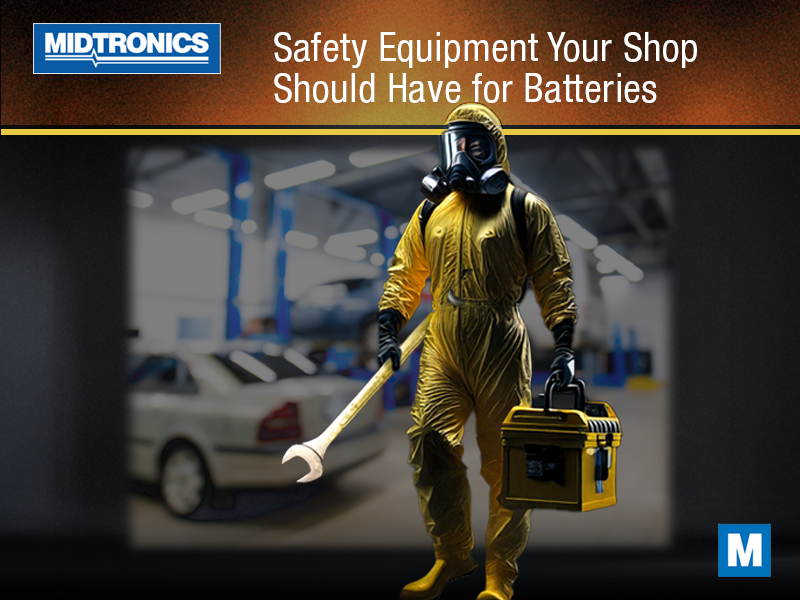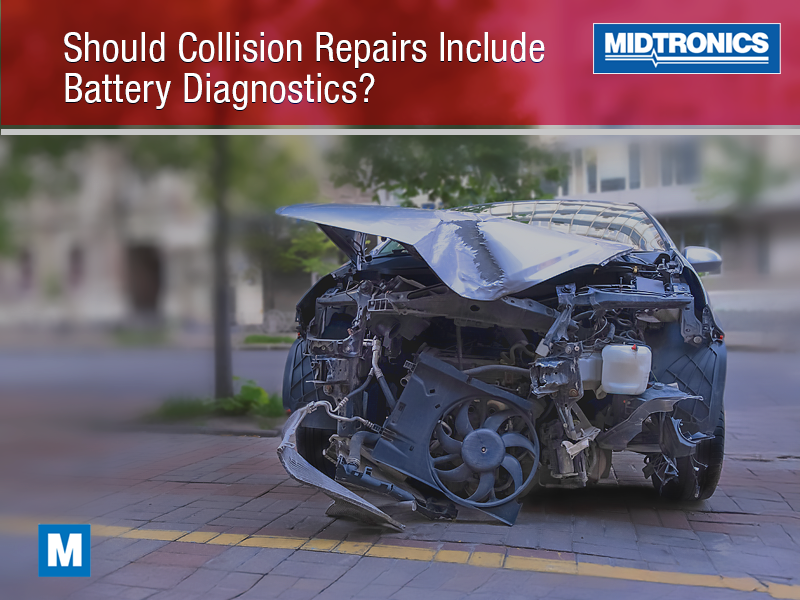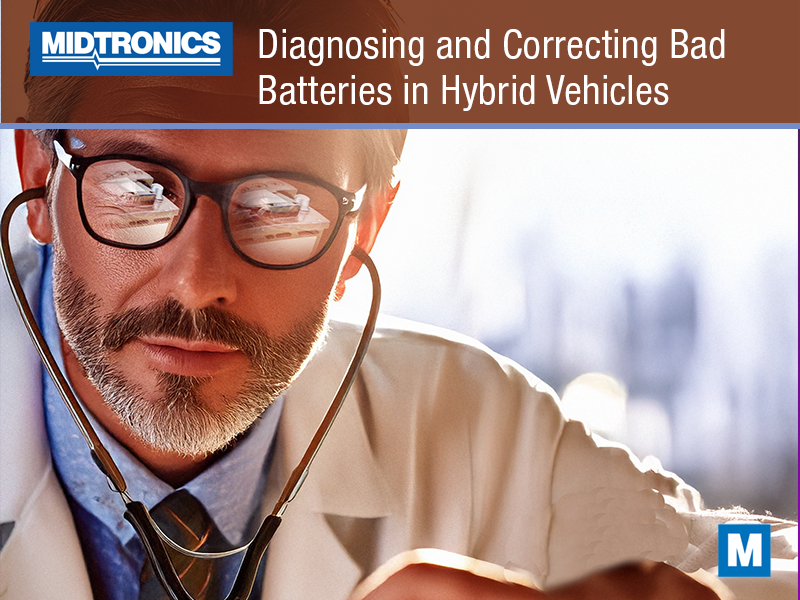Batteries are a staple in every automotive repair shop, but they come with their share of hazards. Whether it’s acid spills, electrical shorts, or even the risk of fire, handling batteries safely requires the right tools and precautions.
For service managers, parts managers, and technicians, having the proper safety equipment in the shop is more than just a compliance requirement – it’s part of creating a safe, efficient, and professional environment. Here’s a rundown of the safety equipment every shop should have for handling, storing, and disposing of batteries.
Personal Protective Equipment
When working with batteries, protecting yourself and your team is the first priority. Personal PPE serves as the frontline defense against acid splashes, sparks, and other hazards. You should have readily available PPE items such as:
- Eye protection. Batteries can emit gases or leak acid during charging, testing, or handling. Safety goggles or face shields provide a barrier that protects eyes from potential injuries.
- Gloves. Acid-resistant gloves are a must. Whether someone is lifting a battery or cleaning up a spill, these gloves shield skin from chemical burns and irritation.
- Aprons. Accidental spills are part of the job when handling batteries. Acid-resistant aprons or lab coats offer an extra layer of protection for clothing and skin.
Make sure PPE is always accessible and in good condition and that only trained service and parts personnel are handling batteries. Regular training on proper usage can help ensure employees are fully protected.
Spill Containment and Cleanup Supplies
Accidental leaks and spills can happen even when batteries are handled carefully. Being prepared with the right containment and cleanup supplies can prevent a small incident from becoming a big problem.
Battery spill kits should be on hand and usually include absorbent pads, acid neutralizers, and cleanup tools designed for battery acid. They allow your team to handle spills quickly and efficiently. Storing batteries on acid-resistant mats or trays helps contain any leaks before they spread. This protects your workspace and reduces cleanup time.
Having these supplies on hand ensures that your shop can respond promptly to spills, minimizing risks to people and equipment. And avoid stacking batteries on top of each other, as well as avoid the potential for other items to fall on top of new batteries or those ready for disposal.
Ventilation
Batteries, especially lead-acid ones, can emit hydrogen gas during charging. Without proper ventilation, this gas can accumulate and create a risk of explosion.
A well-ventilated charging area is a must. Fume hoods or exhaust systems help remove harmful gases from the workspace, keeping the air safe to breathe and reducing fire risks. If your shop doesn’t have a designated ventilation system for battery charging, consider upgrading your workspace to include one.
Battery Handling Tools
Batteries are heavy, awkward to handle, and often contain corrosive materials. Using the right tools not only makes handling safer but also prevents damage to the batteries themselves.
Lifting straps or carriers allow you to lift and transport batteries safely. They reduce the strain on staff and help prevent accidental drops or pulled muscles that could cause lost work.
Sparks near a battery can lead to dangerous situations, especially when flammable gases are present. Non-sparking tools made from materials like brass or bronze are designed to prevent accidental ignition, especially if you know the risk is higher for some reason. Investing in proper handling tools protects both your team and your shop equipment.
Eye Wash Stations and Emergency Showers
Accidents happen, even in the most safety-conscious environments. Being prepared for the worst ensures that injuries can be addressed quickly and effectively.
In the event of an acid splash, a properly located and fully functional eye wash station can prevent serious injuries. These should be readily accessible to everyone in the shop, well marked for identification, and checked regularly to ensure they’re operational.
For larger spills or exposures, an emergency shower provides immediate decontamination. This equipment is essential for reducing the possibility of harm in severe situations.
Both eye wash stations and emergency showers are critical for complying with workplace safety standards and protecting your team.
Fire Safety Equipment
Some batteries, particularly lithium-ion ones, pose a risk of fire if damaged or improperly handled. It’s true whether it’s for high-voltage EV batteries or Li-ion batteries in some equipment in the shop. Having the right fire safety equipment can make all the difference in an emergency.
Unlike standard fire extinguishers, Class D fire extinguishers are specifically designed for fires involving combustible metals, including those found in lithium batteries. Don’t assume your standard fire extinguishers will be sufficient.
Storing batteries in fire-resistant cabinets minimizes the risk of fires spreading in case of an incident. These cabinets are especially important for lithium-ion battery storage. If you’re working on a high volume of Li-ion batteries, this cabinet is an absolute must!
Every shop should also have a clear fire safety protocol and conduct regular drills to keep employees prepared.
Proper Storage and Disposal Equipment
Storing and disposing of batteries properly is just as important as handling them safely. The right equipment ensures batteries remain secure and minimizes environmental risks.
- Battery storage racks. These racks keep batteries upright and secure, reducing the risk of leaks or accidental damage. Proper storage also helps maintain the batteries’ performance and lifespan while on the shelf before they’re sold.
- Recycling bins and disposal containers. Batteries can’t be tossed in the trash. Acid-resistant, clearly labeled containers make it easy to collect used non-automotive batteries for recycling or disposal to comply with local regulations.
Having a designated area for battery storage and disposal shows customers that your shop takes safety and environmental responsibility seriously.
Diagnostic and Testing Equipment
Testing batteries is a routine task in any repair shop, but it should be done with the right diagnostic tools. Safety enters the equation as low-quality or obsolete tools aren’t always capable of testing newer batteries, whether EFB, AGM, or Li-ion. Older tools can still be valuable in certain spaces, but any equipment that’s being used regularly should be newer and able to cover the complete spectrum of 12V batteries to avoid false test results or vehicles that aren’t getting tested.
Conclusion
Having the right safety equipment for battery handling, storage, and disposal is a non-negotiable aspect of running a professional repair shop. From PPE and spill containment supplies to fire safety gear and diagnostic tools, every piece of equipment plays a role in protecting your team and your business.
Take the time to evaluate your shop’s current safety setup. Are there gaps that need addressing? Investing in the right equipment now can prevent costly accidents later and shows your commitment to a safe, professional environment. A well-equipped shop doesn’t just comply with regulations – it earns trust from employees and customers alike.




